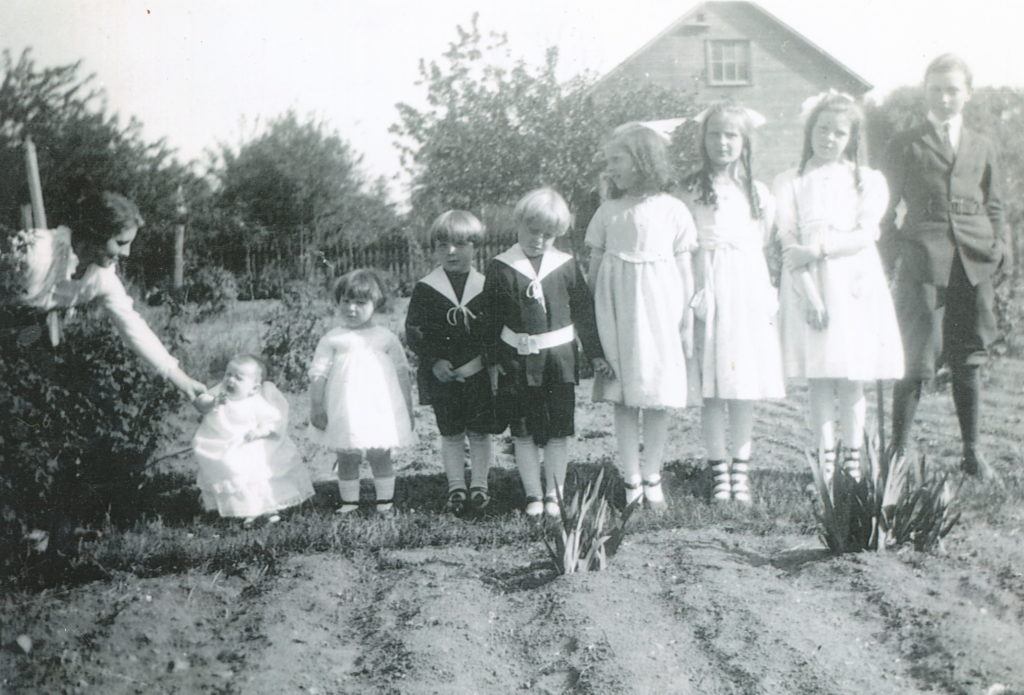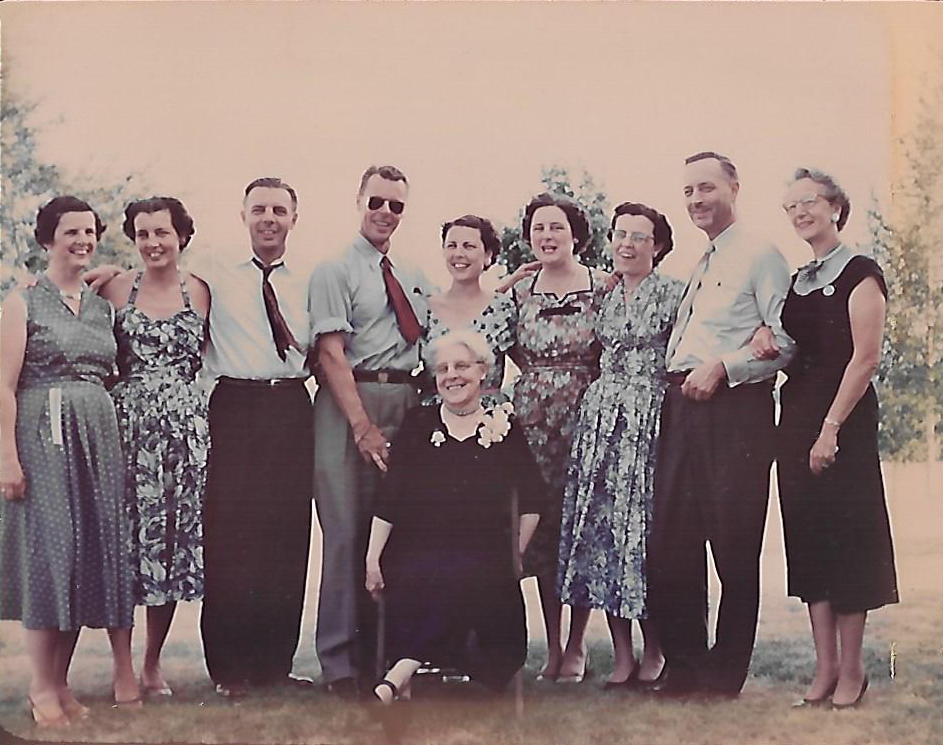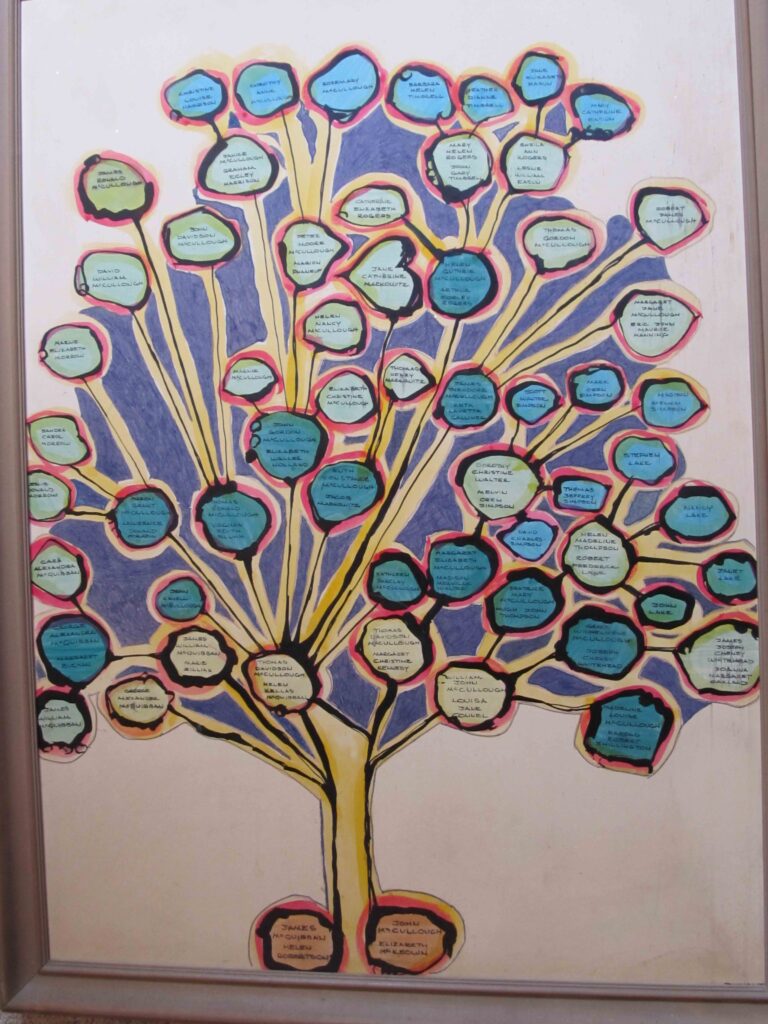At stake

My musings about life and meanings in my life and the lives of others often takes me home, tumbling sometimes. Phil Collins’ Take Me Home – its syncopated, back-beat rhythm and his lyrics – tell me he can’t remember, whereas I hunger to re-member, put my breath back and hone my memories into a sharper perspective. Mostly I see, in my mind’s eye, events, people, concepts, moments…flashes of elements that shape how I think and feel about this miracle that is life. And so for this, my first tumblehome blog, what lures me and has been calling my attention for some time is this image of my mother and her sisters and brothers. What fascinates me is the left side of the picture where my grandmother McCullough (Helen Kellas McQuibban was her name of origin) is holding my mother’s right wrist. What I know about the photo that truly intrigues me is that my mom is tied to a tomato stake, too young, I assume, to be able to stand on her own. Her siblings loved to re-enact the photo, youngest to oldest, as in this image likely from the early 1950s – Marion (Mom), Jean, Ron, Gordon, Kit, Ruth, Helen, Ted, half-sister, Margaret. Not present in the tomato stake photo, Margaret was the daughter of my Grandpa McCullough, the Reverend Thomas Davidson McCullough’s first marriage in 1897 to Margaret Christine Kennedy; sadly, the latter died in 1902 less than 5 years after they were married. My Grandma Mcullough is seated in the centre of the adult family photo. My grandfather McCullough died in 1938; to the best of my knowledge, my Grandma McCullough never remarried…

Marion Grant McCullough – MGM embossed on a hard-cased, olive-green and kind of brown-flecked suitcase – my mother died of a major illness in 1957 when she was just 38 years old. My Grandma McCullough died the same year, two deaths coming so close in time and that must have been very hard on the McCullough family. In passing, my grandmother McCullough and I share the same day of birth, July 27th – I have a vague recollection of co-celebrating at least one of our annual birthdays in the mid 1950s in Kincardine. As for my mother, I remember very, very little about her. So I ponder what I know was at stake for her and I create scenarios of what might her life have been like, and mine, had we known each other longer. Who was she? What and who did she love? What fascinated her? What drew her to my father? What was it like to be held by her and what would it have been like to hold her longer in my life? I tumble home in honour of my mother.
…
About 10 days have passed since I posted this, my first blog, about my mother, at stake. And I have been pondering the things in my life that have been at stake, literally and figuratively. Staking tomatoes in our garden with my father comes to mind and at the other end of the spectrum, the horror of being burned at the stake à la Joan of Arc. In both of those cases, the stake is driven into the earth, grounded then. More though, do the transposed meanings of at stake reverberate in my consciousness. A stake supports, props up, holds straight, and often marks a boundary for a fence or property line. It strikes me that during my life, I have played the role and lived into being someone who longs to support people, especially those who are close to me. I realize as well that with my mother dying when I was so young and my father never re-marrying, I had to stake myself, do things my mother might have done for or with me. How odd it was, I remember, going to friends’ homes and hearing them say ‘Mom’ or observing how much they relied on their mother to do everyday tasks.
I am also keenly aware of boundaries for my behaviour, for what I deem and/or know to feel right for me; in fact, I would say I am fierce about my boundaries, driving, at times, too firm a stake into my everyday ground. Most often though, my boundaries serve me, define me, protect me, and let me live within who I am. At the same time, as I round one of life’s chronological turns toward 70 years of age, I am certain that my boundaries have shifted as my perspectives on how I see the world changed. Perhaps personal boundaries are flexible and move with us as we grow. And I do know I have pushed boundaries, somewhat of a maverick, I think, when it comes to standing up for others, for myself, for what seems right to me especially when something happens ‘up with which I will not put,’ as Winston Churchill is often quoted as saying, regardless of the stature or rank or status of the person I believe has transgressed. An example from the formative stages of my development might suffice.
When I was in grade one, in Centralia, my best friend was Bruce. We didn’t know what it was called at the time, but he was allergic to milk and milk products, likely lactose intolerant. I knew this from having meals with Bruce at my house and his. Early in the school year, in the mid 1950s, we were in a reading circle and we were each offered a glass bottle of milk, probably 10 ounces in size with a carboard tabbed top. Our teacher went round the inside of the circle carrying a small milk crate offering us either chocolate or white milk. When she got to Bruce on the other side of the circle from me, he did everything he could to say ‘no’ but it was the era of belief in the absolute power of milk and white bread, sacrosanct nutritional items. She wouldn’t stop insisting and Bruce couldn’t stop crying – I had to do something to stop her. Grabbing my own milk-container, now opened, I scuttled across the room reaching her backside as she stooped over Bruce. Unaware of the sheerness of nylon stockings, I grabbed the top of one of her stockings – gartered as I now suspect it must have been – and poured the milk from my bottle down her leg. It had the desired effect, got me in a tonne of trouble, and yet cemented my boundary-awareness thinking and behaviour.
Finally, I am aware of the one letter difference between stake and sake. In an experiential leadership learning course some years ago, we were taught the importance of naming what is at stake or what stake one metaphorically – metaphor, it is said, is wisdom’s oldest tool – drives into the ground in teaching or working with others – the centrifugal point of a lecture or workshop or group meeting…for the sake of what? And maybe even this notion, centrifugal, harkens to my boyhood when my father taught me so vividly the power of that force by having me swing a small pail full of water in a full circle perpendicular to the ground without spilling a drop even when upside down. Now, much later in life, working with clients and groups doing or teaching motivational interviewing – certainly for most of my career as a university professor – I am always aware of the stake or focus or main agenda item…for the sake of what am I teaching this or formulating my next question or reflection. What serves, others and self, is often, if not always what is at stake. To return to my mother’s tomato stake, I was able to find out a lot about my mother’s and my ancestry through the McCullough family history. For the sake of having this record, I insert the McCullough family genealogy 2018 here (added in November 2022). Someone in the McCullough family took the time in the early 1970s to create a McCullough / McQuibban family tree – quite literally using a tree design – and I used it to fill in some of the details in the genealogy link above. A jpeg image of that handwritten, hand-painted tree can be seen either at this link, McCullough / McQuibban family tree or in the image below with the same label under the picture. In either case, the image is compressed and very small; however, if you click on the image, you can save it as a jpeg and open it in an image app/browser on your device and then use the magnification tool to enlarge any portion of it. How perfectly fitting that the ‘stake’ theme of this blog should be bracketed by the wooden tomato stake at the start and by the family ‘tree’ at the end. And still, I tumble home to the names of people that surround and contain my mother’s name, a representation of family and her life cut so short…

